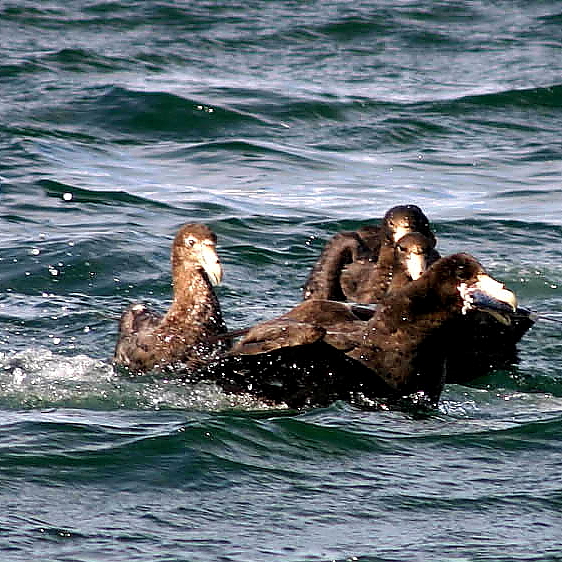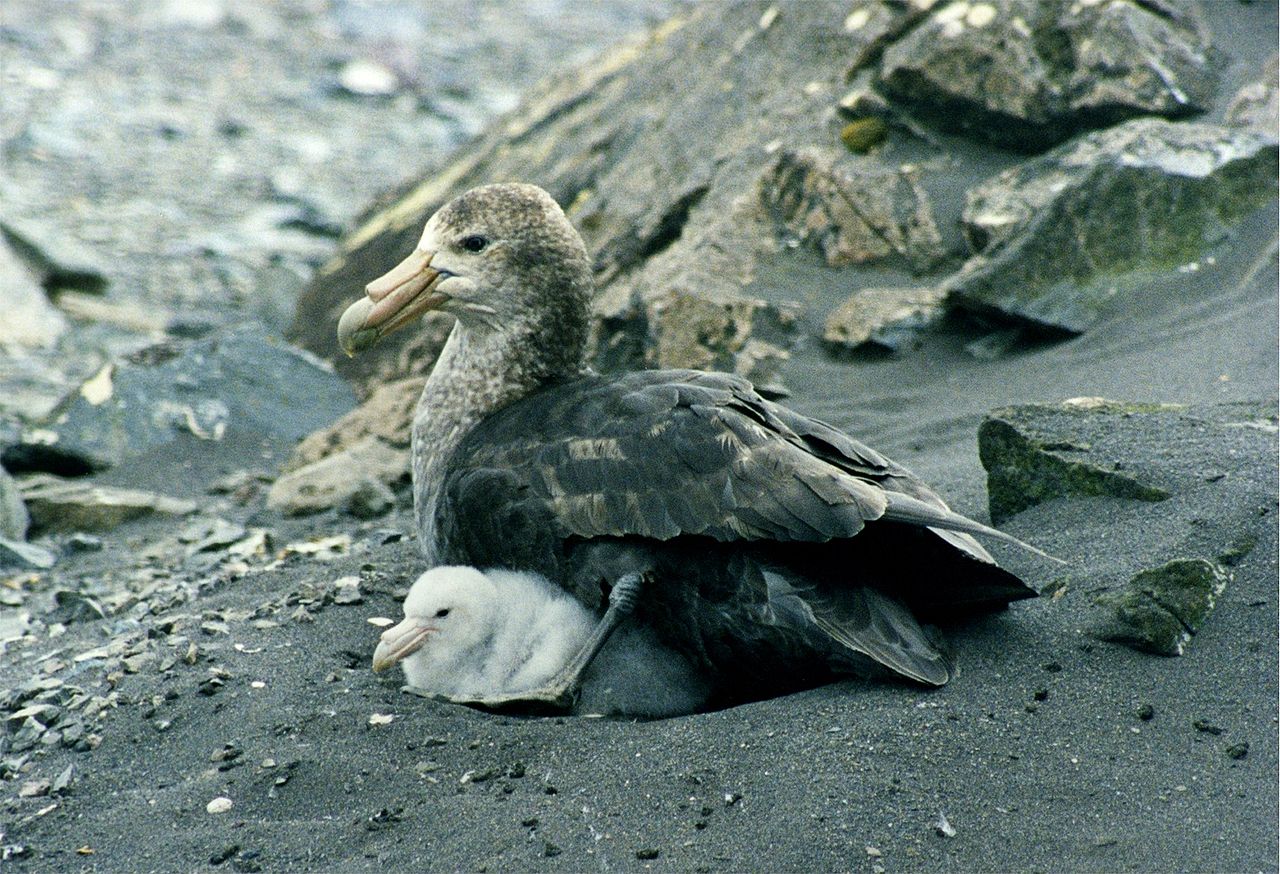Southern giant petrel
The southern giant petrel (Macronectes giganteus), also known as the Antarctic giant petrel, and stinkpot, is a large seabird of the Southern Ocean. Its distribution overlaps broadly with the similar northern giant petrel, though it overall is centered slightly further south. Adults of the two species can be distinguished by the color of their bill-tip: greenish in the southern and reddish in the northern.
Description
This and its sister species are the largest members of the Procellariidae. The southern giant petrel measures 86 to 99 cm (34–39 in) with a wingspan of 185 to 205 cm (73–81 in). Both this and the northern giant petrel vary considerably in size, with southern colonies averaging larger than northern colonies, in line with Bergmann's rule. Due to the large amount of size variability, it is difficult to determine which is the larger species, but the largest bodied colonies of the southern species are slightly larger on average, in both mass and linear dimensions, than the largest in the northern giant petrel.
Body mass can vary widely, from 2.3 to 5.6 kg (5.1–12.3 lb), with males averaging larger than females. The largest average weights come from Macquarie Island, where 20 males averaged 5.14 kg (11.3 lb) and 21 females averaged 4.2 kg (9.3 lb). On the South Orkney Islands, 37 males averaged 4.94 kg (10.9 lb) and 37 females averaged 3.85 kg (8.5 lb). In contrast, in Patagonia, 15 males averaged 3.5 kg (7.7 lb) and 21 females averaged 2.5 kg (5.5 lb). However another study from Patagonia, found that 26 males averaged 4.2 kg (9.3 lb) and 27 females averaged 3.7 kg (8.2 lb). They have a very large yellow bill, with a green tip and greyish-brown legs. There are two different morphs, the dark which resembles the northern giant petrel, and the more distinct light morph. On the dark morph the upper breast, head and neck are light with the remainder of its plumage being mottled brown. The leading edge of its wing is lighter as is the base of the inner primaries, on the underside. The light morph is rarer and very distinct with only slight black speckles on an otherwise all white look. As juveniles, the dark morph starts off more sooty brown and pales as it ages. Both giant petrels have strong legs and can move around on land effectively. Finally, when in flight this species has a somewhat hunchbacked appearance.
It, like all members of the Procellariiformes have certain features that set them apart from other birds. First, they have nasal passages that attach to the upper bill called naricorns. Although the nose holes on the petrels are on the top of the bill. The bills of all Procellariiformes are also unique in that they are split into between seven and nine horny plates. Finally, they produce a stomach oil made up of wax esters and triglycerides that is stored in the proventriculus. This can be sprayed out of their mouths as a defense against predators as well as used as an energy rich food source for chicks and for the adults during their long flights. They also have a salt gland that is situated above the nasal passage and helps desalinate their bodies, due to the high amount of ocean water that they imbibe; it excretes a concentrated saline solution from the nostrils.
Behavior
The southern giant petrel achieves sexual maturity at six or seven years of age; however the average age of first breeding is ten years. Its breeding season begins in October. Its nest is a mound of moss, grass, and stones with a depression in the center and is located on bare or grassy ground. They form loose colonies except in the Falkland Islands where the colonies are much larger.
One immaculate white egg that is 103 by 70 millimetres (4.1 by 2.8 in) is laid. It is incubated for 55–66 days, where it is always guarded by at least one of the parents. When the white chick is born it is brooded for two to three weeks and it fledges at 104–132 days.
This petrel will feed on krill, squid, and offal in coastal and pelagic waters, and unlike most other Procellariiformes, this bird will eat carrion and even attack smaller seabirds. The males exclude females from the carcasses that they are feeding on.
Range
The range of this bird is quite large as it ranges from Antarctica to the subtropics of Chile, Africa, and Australia, and has an occurrence range of 36,000,000 km2 (14,000,000 sq mi). It breeds on numerous islands throughout the Southern Ocean. The islands with larger populations include the Falkland Islands, South Georgia, South Orkney Islands, Staten Island, South Shetland, Heard Island, Macquarie Island, the Prince Edward Islands, and the Crozet Islands.
The other locations with small populations are the Kerguelen Islands, Gough Island, Tristan da Cunha, Diego Ramirez, Isla Noir as well as four locations on the continent of Antarctica, including Adélie Land, and small islands off the coast of Argentina near Chubut Province. The colonies are visited year round.

